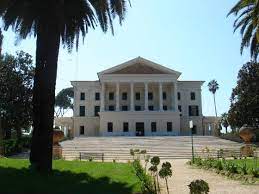Marina Torlonia di Civitella-Cesi (1916–1960): A Tragic Tale of Nobility and Endurance

Marina Torlonia di Civitella-Cesi, born in 1916, was a member of the prestigious Torlonia family, one of the most prominent noble families in Italy. Her life unfolded against the backdrop of significant historical events, and her story is a compelling blend of aristocratic privilege, personal struggle, and tragedy. Despite being a woman of considerable wealth and privilege, Marina faced challenges that transcended societal expectations, leaving a lasting impact on the Torlonia legacy.
The Early Years:
Marina Torlonia was born into a world of opulence and tradition. The Torlonia family had amassed immense wealth through banking and real estate, making them one of the wealthiest families in Italy. Marina grew up surrounded by the lavishness of the Torlonia estates, including the magnificent Villa Torlonia in Rome, which served as the family’s main residence.
Despite the family’s affluence, Marina’s childhood was marked by the social constraints and expectations imposed on women of her class. The Torlonia family, like many aristocratic families of the time, adhered to traditional gender roles, limiting the opportunities for women to pursue education and careers outside the domestic sphere. Marina, however, displayed an early intellectual curiosity and a passion for the arts, setting her apart from the conventional expectations of her upbringing.
World War II and Its Impact:
The outbreak of World War II in 1939 brought unprecedented challenges to Marina and her family. Italy, led by Benito Mussolini, aligned itself with Nazi Germany, and the Torlonia family found themselves in the midst of political turmoil. Marina’s privileged lifestyle was disrupted as the war brought economic hardship, and the family’s properties faced requisition by the occupying forces.
Marina’s response to the war demonstrated resilience and a sense of duty. She actively participated in charitable activities, helping those affected by the conflict. Her determination to make a positive impact on the lives of others showcased a different side of the Torlonia heiress – one that transcended the boundaries of her aristocratic background.
Love and Loss:
In the midst of wartime uncertainty, Marina found love in the arms of a young man from a different social stratum. Her romance with a commoner challenged the rigid social norms that governed the Torlonia family. Despite the odds, Marina followed her heart, and the couple married in secret, away from the prying eyes of society.
Tragically, Marina’s happiness was short-lived. Her husband, drafted into the Italian military, lost his life in the war. The loss left Marina devastated, a widow at a young age, and she faced the challenges of rebuilding her life amidst the ruins of post-war Italy.
Legacy of Philanthropy:
Marina Torlonia, now widowed and burdened with the responsibilities of managing the family’s dwindling fortunes, redirected her energies towards philanthropy. Her experiences during the war had ignited a passion for social justice, and she became actively involved in charitable work. Marina championed causes related to education, healthcare, and support for war widows and orphans.
In an era when the aristocracy’s influence was waning, Marina sought to redefine the role of the privileged class. Instead of clinging to outdated traditions, she used her resources to uplift the less fortunate. Her commitment to philanthropy earned her respect beyond the aristocratic circles, turning Marina into a symbol of compassion and progress.
The Torlonia Legacy:
Marina’s life exemplified the complexities and contradictions of aristocratic existence in the 20th century. Born into privilege, she confronted societal expectations, endured personal tragedies, and emerged as a figure of substance and compassion. The Torlonia legacy, once synonymous with wealth and nobility, took on a new dimension through Marina’s actions.
The Torlonia family’s properties, including the famed Villa Torlonia, underwent transformations in the post-war period. Marina’s commitment to philanthropy and social causes influenced the family’s legacy, marking a departure from the traditional image of aristocrats hoarding wealth and power. The Torlonia name became associated not only with grand estates and financial prowess but also with a commitment to social responsibility.
Conclusion:
Marina Torlonia di Civitella-Cesi’s life is a poignant narrative that transcends the confines of aristocratic stereotypes. Her journey from a privileged heiress to a philanthropist with a social conscience reflects the seismic shifts in Italian society during the mid-20th century. Marina’s legacy endures not only in the grandeur of the Torlonia family estates but also in the lives touched by her charitable endeavors. In remembering Marina Torlonia, we are reminded that true nobility lies not merely in lineage or wealth but in the transformative power of compassion and resilience.
-
Who was Marina Torlonia di Civitella-Cesi?
Marina Torlonia di Civitella-Cesi (1916–1960) was a member of the illustrious Torlonia family, one of Italy’s most affluent and influential noble families. She lived during a tumultuous period in Italian history, marked by World War II and its aftermath.
- What distinguished the Torlonia family?
The Torlonia family gained prominence through their success in banking and real estate, amassing significant wealth that made them one of the wealthiest families in Italy. They were known for their opulent lifestyle, owning grand estates such as the Villa Torlonia in Rome.
-
How did World War II impact Marina Torlonia and her family?
World War II brought economic hardship and political turmoil to Italy, affecting even the affluent Torlonia family. Their properties faced requisition by occupying forces, leading to a significant change in their circumstances.
-
Did Marina Torlonia face societal constraints despite her privileged background?
Yes, despite her aristocratic upbringing, Marina faced societal expectations and gender roles that limited opportunities for women of her class. However, she displayed intellectual curiosity and a passion for the arts that set her apart.
-
What was Marina Torlonia’s response to World War II?
Marina actively participated in charitable activities during the war, helping those affected by the conflict. Her experiences ignited a passion for social justice and philanthropy, leading her to champion causes related to education, healthcare, and support for war widows and orphans.
-
Did Marina Torlonia experience personal tragedy during the war?
Yes, Marina’s personal life was marked by tragedy when she married a commoner in secret, only to lose him to the war shortly afterward. This left her widowed at a young age and added to the challenges she faced in rebuilding her life.
-
How did Marina Torlonia contribute to philanthropy and social causes?
Following the war, Marina redirected her energies towards philanthropy, becoming actively involved in charitable work. She focused on causes related to education, healthcare, and support for war widows and orphans, leaving a lasting impact on the Torlonia legacy.
-
What was Marina Torlonia’s influence on the Torlonia legacy?
Marina’s commitment to philanthropy and social responsibility influenced the Torlonia legacy. The family’s properties, including Villa Torlonia, underwent transformations, and the Torlonia name became associated not only with wealth but also with a commitment to making a positive impact on society.
-
How is Marina Torlonia remembered today?
Marina Torlonia di Civitella-Cesi is remembered as a symbol of resilience, compassion, and progress. Her life story serves as a reminder that true nobility extends beyond lineage and wealth, encompassing the transformative power of empathy and social responsibility.
-
What is the significance of Marina Torlonia’s life in Italian history?
Marina Torlonia’s life is significant in reflecting the complexities of aristocratic existence in mid-20th century Italy. Her journey from privilege to philanthropy mirrors the societal shifts of the time, making her a noteworthy figure in the country’s history.






